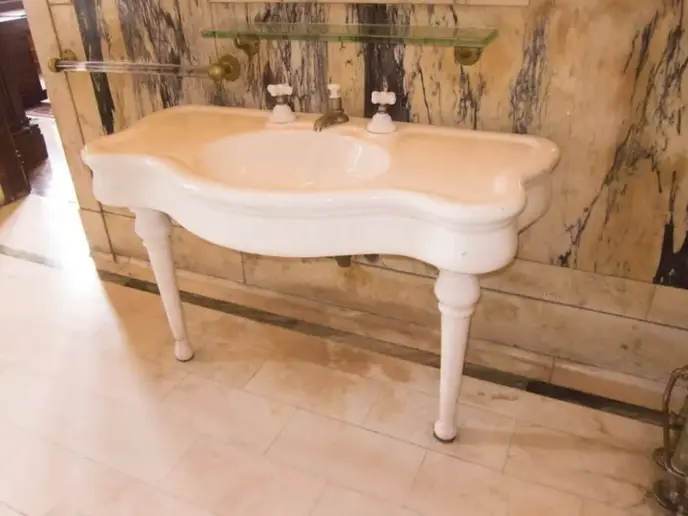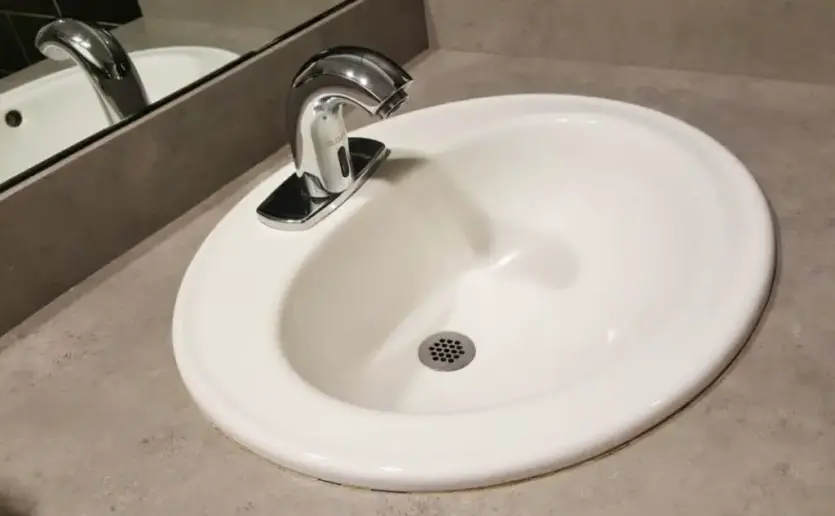Porcelain vs Ceramic Sink – Which One Is Better
The sink is the spot in the bathroom where we probably spend the most time.
Due to its heavy use, durability and ease of maintenance are probably the first things on the mind of homeowners when picking a sink.
However, it’s also the first thing that anyone who enters the bathroom sees and the focal point of the bathroom’s interior.
So, besides being convenient and useful, the sink also significantly contributes to the overall aesthetics of the bathroom.
Bathroom sinks can be made from various materials and come in all sorts of shapes and sizes, with porcelain and ceramic being the most popular choices.
Still, when comparing porcelain vs ceramic sink, you’ll see that they look pretty similar and many people are unsure which material is best for their bathroom.
Below, you’ll learn how these two differ and which is a better fit for certain types of homeowners.
So, let’s dive in!
Porcelain Sink – Information

When it comes to what you want from your sink, porcelain is the material that checks almost all boxes.
It’s extremely tough, durable, and, with proper maintenance, it can last for decades.
At the same time, it has a very soft, shiny, smooth, and elegant appearance, typically favored by homeowners.
Plus, it can be shaped in any way you like.
Material
Basically, porcelain is a ceramic material made from refined hard clay, primarily kaolin, a fine silicate-based clay mineral.
The basic material is heated to make it less porous and dense.
Commonly, the clay mixture is heated in a kiln or an oven at a temperature between 1,200 and 1,400 degrees Fahrenheit.
The firing triggers a physical reaction that turns the clay texture into a glossy and smooth finish, similar to glass.
Porcelain sinks are manufactured in a couple of different ways.
They can be made of solid fireclay, but the porcelain can also be used as a coating over cast iron or stainless steel.
The latter is the more modern method where the porcelain is fused to the metal at significantly high heat.
The porcelain used to make these types of sinks is mixed with glass and metal to more strong and resistant to chemicals and heat.
Maintenance
Porcelain sinks truly add a lot to the overall appeal of your bathroom, but only if they’re clean and shiny.
During everyday use, soap scum, dirt, grease, or hair can easily build up in the sink, creating an unpleasant sight.
The good news is that maintaining a porcelain sink is fairly easy and simple.
However, it should be done regularly, investing a bit of cleaning effort every day, if possible.
Porcelain sinks are best cleaned using dishwashing liquid, or any all-purpose mild cleaner.
Avoid using abrasive cleaning products or those with a high acid content, such as vinegar.
After washing the sink, always remember to wipe it with a dry soft cloth. This will prevent water stains and eliminate traces of soap.
Pros and Cons of Porcelain Sinks
As I noted, porcelain is a great option for a bathroom sink. Still, there are some drawbacks.
Below are the main advantages and disadvantages of using a porcelain-made sink.
Pros:
- Strong, tough, and durable, especially when it comes to sinks with metal bases. There are 100-year-old porcelain sinks still in use.
- Available in a wide range of colors. While the white porcelain sink is the most common variant, you can choose among plenty of other color options.
- Very easy to maintain and clean. Porcelain sinks require much less of a cleaning effort compared to some other sink materials.
- Fairly affordable in comparison to some other options.
Cons:
- Relatively high risk of chipping. Porcelain sinks are prone to chipping, especially when subjected to heavy impact. For example, if you carelessly drop something heavy in it. So, some caution is always advised.
- While they’re available in various colors, porcelain sinks rarely feature intricate patterns and designs, which can limit your creative freedom when decorating the bathroom.
Ceramic Sink – Information

Ceramic sinks are probably the most widely spread type of sinks and a common sight in bathrooms around the world.
They’re mostly used by people who want to give their bathrooms a more classical look.
Ceramic sinks work great with vintage-style bathroom fixtures and furniture. In addition, they’re made from natural materials, making them very environment-friendly.
Material
The process of manufacturing ceramic sinks involves several different materials. Ceramic is made by blending together clay, fluxes, fillers, and water.
Often, the mixture will also include quartz, kaolin, or feldspar. This mixture is fused together and sculpted into various shapes.
For sinks, the bowl shape is, of course, the most common. Sculpting is often done by hand.
In order to make this blend harder, it goes through the firing process where it’s exposed to temperatures of about 2,200 degrees Fahrenheit.
Another option is to use low fire clays which are heated at around 1,200 degrees Fahrenheit.
Sinks made this way will not have high-quality glazing and may be more susceptible to wear and tear.
It’s said that, because of the natural materials in use and firing process, no two ceramic sinks look exactly alike.
Maintenance
Due to their waterproof and smooth surfaces, ceramic sinks are rather resistant to dirt and stains. as there are no small nooks and crevices, the dirt and grime commonly have nowhere to seep in.
Still, the everyday use will make them soiled and stained unless cleaned regularly.
In most cases, just wiping the wet ceramic surface with a dry and soft cloth on a regular will keep the stains away.
For more stubborn dirt, you can use a mild abrasive, such as baking soda.
It’s a good idea to combine baking soda with lemon juice to regain natural color in the darkened areas.
You should never use highly abrasive cleaning solutions or pads made of wire or metal.
Most manufacturers have cleaning products made specifically for ceramic, so make sure to carefully read the label.
Pros and Cons of Ceramic Sinks
Before you decide to add a ceramic sink to your bathroom, you should be aware of all the benefits, but also the downsides of installing one in your house.
Pros:
- Very durable and capable of taking a lot of beating during regular use. Ceramic sinks are highly immune to scratches and chips.
- Similar to porcelain ones, ceramic sinks are very easy to clean. When given proper attention, they’re fairly resistant to stains and bacteria growth.
- As they’re available in various shapes, sizes, and colors, ceramic sinks can fit great with any bathroom.
Cons:
- Exposure to intense physical impact or highly abrasive cleaning materials can compromise the glazing. The area around the chipped glazing can quickly become discolored.
- Ceramic sinks are fairly heavy and will commonly need plenty of support which is something to pay attention to during installation.
How to Tell if Bathroom Sink is Porcelain or Ceramic?
As they share a similar appearance, many people confuse porcelain and ceramic sinks and can’t tell one from another.
And, indeed, they are very difficult to tell apart, especially for amateurs. In mint condition, both feature a similar translucent and smooth surface.
Most ceramic sinks go through a glazing process which makes them just as glossy as the ones made of porcelain.
Only when a sink is a bit chipped you may notice the difference between the two.
If you have a ceramic sink, then a tan or white base of the wall will be visible in the chipped area.
Of course, the easiest way to find out what type of sink you have is to check the instruction manual or a product code and do some research on the internet.
Porcelain vs Ceramic Sink – Which One is Better?
When deciding which type of sink is better for your bathroom and comparing porcelain vs ceramic sink, you should consider several factors.
Porosity
The most important thing for the sink is, of course, to be water-resistant.
Because they’re made for finer clay and shaped under more pressure, porcelain sinks are less porous.
Ceramic sinks need to be glazed to be water-proof, but a small chip can easily compromise the glazing.
Durability and Toughness
The way they’re manufactured also gives porcelain sinks an advantage when it comes to durability.
Ceramic sinks are also known for durability, but there’s always a danger of them being shattered if you drop something heavy in the bowl.
Porcelain is also more scratch-resistant, but proper care will prevent scratches on either type of sink.
However, ceramic sinks are cheaper and easier to repair if needed.
Appearance
For many, design and appearance are also important.
While porcelain sinks are commonly available in more different colors and patterns, ceramic ones provide more freedom with shapes and designs and add a more classic look to your bathroom.
Price
Finally, porcelain sinks are more budget-friendly.
Compared to ceramic sinks, they’re commonly cheaper both in the starting range and in the premium group of products.
Conclusion
Durability, style, ease of maintenance, and price of bathroom sink all depend on the material from which a particular sink is made.
Understanding the advantages of specific materials will help you make the right choice when shopping for a new sink for your bathroom.
Two of the most popular options are ceramic and porcelain sinks and for a good reason.
Both types are very durable, water-resistant, and easy to maintain.
On the other hand, ceramic sinks, while more expensive, come in more intricate designs and add more class to the bathroom interior.



















































































